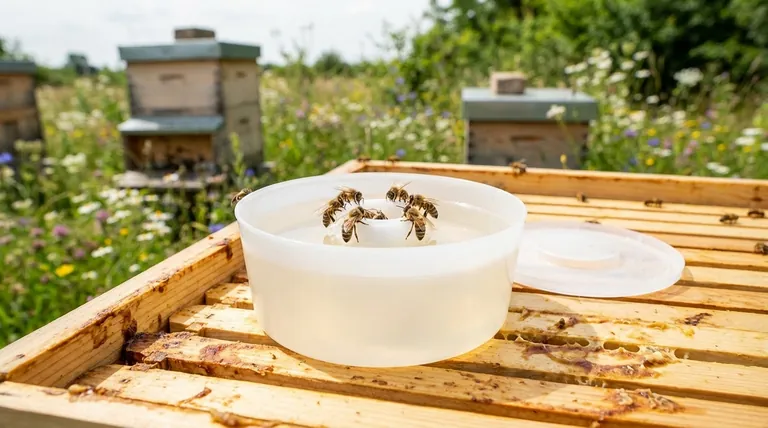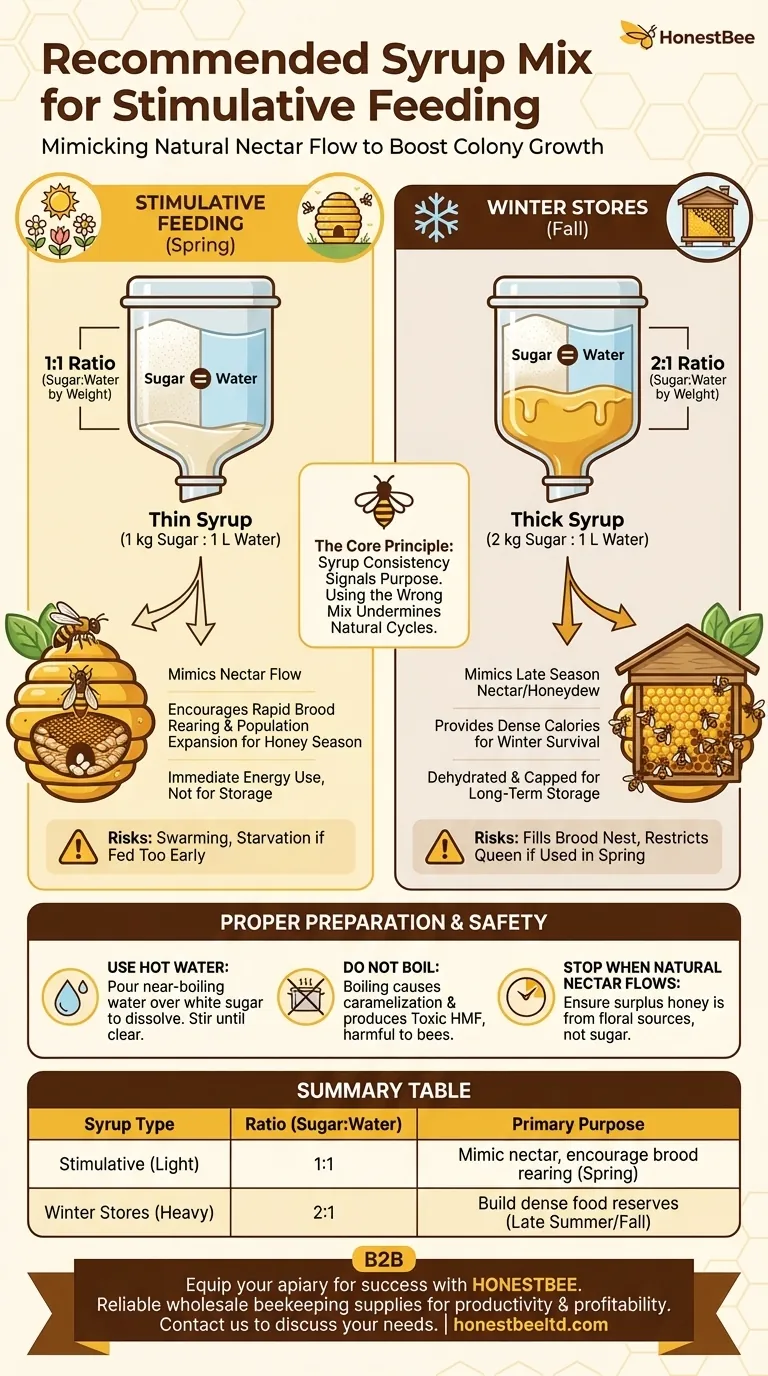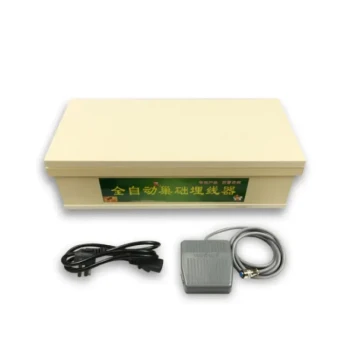The recommended syrup mix for stimulative feeding is a light syrup made from a one-to-one (1:1) ratio of sugar to water by weight. This formulation is designed to mimic a natural spring nectar flow. The goal is not to have the bees store it as food, but to encourage the queen to increase her rate of egg-laying and expand the colony's population in preparation for the main honey season.
The core principle is simple: syrup consistency signals a specific purpose to the bees. A thin, 1:1 syrup simulates a nectar flow and stimulates brood rearing, while a thick, 2:1 syrup provides dense calories for building winter food stores. Using the wrong mix at the wrong time can undermine your colony's natural cycle.

Why Syrup Ratio Matters: Mimicking Nature
The ratio of sugar to water in your syrup is a signal you send to the hive. The bees' response to a thin syrup is fundamentally different from their response to a thick one.
The Goal of Stimulative Feeding
The purpose of stimulative feeding is to "trick" the colony into believing a strong nectar flow has begun earlier than it has naturally.
This perceived abundance triggers a biological response: the queen dramatically increases her egg-laying to build the workforce needed to collect the incoming resources.
The 1:1 "Nectar" Syrup
A 1:1 ratio by weight is the standard for spring stimulation. This means using one pound of sugar for every one pound (one pint or two cups) of water. In metric terms, this is one kilogram of sugar per one liter of water.
This light consistency is easy for bees to consume and process quickly. It doesn't require significant effort to dehydrate, so they consume it for immediate energy, feeding the rapidly growing brood population.
The 2:1 "Winter Stores" Syrup
In contrast, fall feeding uses a heavy 2:1 syrup, made of two parts sugar to one part water by weight (e.g., 2 lbs of sugar per 1 pint of water).
This thick syrup is difficult to consume quickly and is intended for storage. The bees will dehydrate it and cap it in the comb, creating the essential food reserves they need to survive the winter. Using this thick syrup in spring can fill the brood nest with stores, leaving the queen no room to lay.
Understanding the Trade-offs and Risks
Stimulative feeding is a powerful tool, but it is not without risks. Mismanagement can set your colony back significantly.
The Risk of Feeding Too Early
If you stimulate the queen to lay and the population booms before natural pollen and nectar are available, the colony can starve. A large population consumes resources at a very high rate.
The Danger of Swarming
Over-stimulation can lead to a rapidly expanding, congested brood nest. This is a primary trigger for the swarm impulse, where the old queen leaves with half the bees. This defeats the purpose of building a strong colony for honey production.
Attracting Pests and Robbing
Any spilled syrup or poorly designed feeder can act as a beacon for ants and, more dangerously, robber bees from neighboring hives. A robbing frenzy can quickly destroy a weaker colony.
Proper Preparation and Safety
How you mix your syrup is as important as the ratio you use. Following correct procedure ensures the syrup is beneficial, not harmful.
Mixing Your Syrup Correctly
Always use pure white granulated sugar. Pour hot, near-boiling water over the sugar and stir until the crystals are completely dissolved. The final liquid should be clear.
Why You Must Not Boil the Syrup
Never boil the sugar and water mixture. Boiling can cause the sugars to caramelize and produce a compound called Hydroxymethylfurfural (HMF).
HMF is toxic to bees and can cause dysentery and bee death, undermining your entire effort.
When to Stop Feeding
Stimulative feeding should be seen as a temporary bridge. As soon as natural nectar sources become plentiful, you must stop feeding. This ensures the honey your bees store in their surplus boxes is made from floral nectar, not white sugar.
Making the Right Choice for Your Goal
Ultimately, the syrup you use must align with your specific objective for the colony at that point in the season.
- If your primary focus is stimulating spring buildup: Use a thin 1:1 syrup (by weight) to encourage the queen to expand the brood nest.
- If your primary focus is building winter food stores: Use a thick 2:1 syrup (sugar to water by weight) to help the colony create dense reserves for winter.
- If your primary focus is drawing new comb or emergency feeding: Use an intermediate 1:1 syrup to provide the high energy needed for wax production without clogging the brood nest.
By understanding these principles, you can use feeding as a precise and strategic tool to guide your colony toward health and productivity.
Summary Table:
| Syrup Type | Ratio (Sugar:Water by Weight) | Primary Purpose | Best Used |
|---|---|---|---|
| Stimulative (Light) | 1:1 | Mimic nectar flow, encourage brood rearing | Spring / Early Season |
| Winter Stores (Heavy) | 2:1 | Build dense food reserves for winter survival | Late Summer / Fall |
Equip your apiary for success with HONESTBEE.
Just as the right syrup ratio is critical for colony health, having reliable, high-quality beekeeping supplies is essential for productivity and profitability. HONESTBEE is your trusted wholesale partner, supplying commercial apiaries and equipment distributors with the durable tools they need to thrive.
Let us help you build a stronger operation. Contact our team today to discuss your wholesale supply needs.
Visual Guide

Related Products
- Rapid Bee Feeder White Plastic 2L Round Top Feeder for 8 or 10-Frame Bee Hives
- HONESTBEE Advanced Ergonomic Stainless Steel Hive Tool for Beekeeping
- Professional Dual-End Stainless Steel Hive Tool for Beekeeping
- No Grafting Queen Rearing Kit: System for Royal Jelly Production and Queen Rearing
- Professional 3-Bar Frame Grip with Integrated Hive Tool
People Also Ask
- What are the recommended sugar-to-water ratios for making sugar syrup for bees? Optimize Your Hive's Health
- What is the capacity of the round hive top feeder for syrup and pollen? A Guide to Targeted Apiary Support
- What is the best thing to feed bees? A Guide to Supplemental Feeding for a Thriving Hive
- What is the advice regarding feeding bees to limit brood production based on? Managing Prolific Bee Strains
- How do you set up and use a top feeder for bees? A Step-by-Step Guide for Safe Feeding



















